-
Details
- Place where the work was made
-
West Bengal
→
India
- Period
- Pala Period circa 760 - 1142 → India
- Date
- early 11th century
- Media category
- Sculpture
- Materials used
- phyllite
- Dimensions
- 56.0 cm x 24.0 cm
- Signature & date
Not signed. Not dated.
- Credit
- Gift of Mr S. Matsuno 1995
- Location
- Not on display
- Accession number
- 41.1995
- Copyright
- Share
-
-
About
Surya, the universal sun god, is one of the five principal deities of the Hindu pantheon (together with Shiva, Vishnu, Ganesha and Devi). He is identified with Saturn in the worship of the nine planets ('navagrahas'). Worship of Surya has been prevalent in India from very early times (c. third millennium BC). In the early Kushana period (c. first/second century AD) under Iranian influence, there emerged in North India the form of Surya as seen in this relief - the deity in a frontal position, carries full blown lotuses in his hands, and stands on a chariot to which are yoked seven horses. In this symmetrically stele, Surya is crowned by a kirtimukha and accompanied by his two consorts Ushas (Dawn) and Chaya (Shade). Two male attendants Danda (staff) and Pingala (scribe) are also depicted.
Asian Art Department, AGNSW, March 1995
-
Exhibition history
Shown in 1 exhibition
East of India - forgotten trade with Australia, Australian National Maritime Museum, Sydney, 01 Jun 2013–18 Aug 2013
-
Bibliography
Referenced in 1 publication
-
S.B.Singh, Arts of Asia, 'SURYA: The universal sun god', pp 83-87, Hong Kong, Nov 1994-Dec 1994, 83-87.
-
